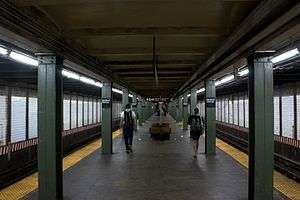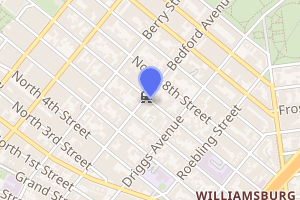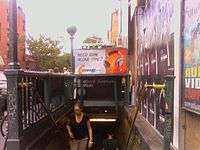Bedford Avenue station
Bedford Avenue is a station on the BMT Canarsie Line of the New York City Subway. Located at the intersection of Bedford Avenue and North Seventh Street in Williamsburg, Brooklyn, it is served by the L train at all times. With an annual total of 9,388,289 passengers for 2015, Bedford Avenue is the busiest subway station in Brooklyn outside of Downtown Brooklyn, as well as the busiest station in Brooklyn served by one subway service.[4]
Bedford Avenue | |||||||
|---|---|---|---|---|---|---|---|
 Station platform | |||||||
| Station statistics | |||||||
| Address | Bedford Avenue & North Seventh Street Brooklyn, NY 11211 | ||||||
| Borough | Brooklyn | ||||||
| Locale | Williamsburg | ||||||
| Coordinates | 40.71772°N 73.95756°W | ||||||
| Division | B (BMT) | ||||||
| Line | BMT Canarsie Line | ||||||
| Services | L | ||||||
| Transit connections | ⛴ NYC Ferry: East River Route (at North Sixth Street west of Kent Avenue) | ||||||
| Structure | Underground | ||||||
| Platforms | 1 island platform | ||||||
| Tracks | 2 | ||||||
| Other information | |||||||
| Opened | June 30, 1924 | ||||||
| Station code | 120[1] | ||||||
| Accessible | |||||||
| Wireless service | |||||||
| Opposite-direction transfer available | Yes | ||||||
| Traffic | |||||||
| Passengers (2019) | 7,836,366[3] | ||||||
| Rank | 45 out of 424[3] | ||||||
| Station succession | |||||||
| Next west | First Avenue: L | ||||||
| Next | First Avenue: L | ||||||
| Next east | Lorimer Street: L | ||||||
| Next | Myrtle–Wyckoff Avenues: L | ||||||
| |||||||
| |||||||
| |||||||
History
Bedford Avenue opened on June 30, 1924, as part of the initial segment of the underground Canarsie Line that originally stretched from Sixth Avenue station in Manhattan to Montrose Avenue station,[5] built by the Brooklyn–Manhattan Transit Corporation (BMT) under the Dual Contracts.[6][7][8]
As part of the wide scope in the rebuilding of the Canarsie Tubes that were damaged during Hurricane Sandy, the Metropolitan Transportation Authority started renovating the station in 2017.[9] At the Bedford Avenue end of the station, two new street-level stairways are being built, platform stair capacity is being increased, the mezzanine is being expanded, turnstiles are being added, and new elevators were installed and opened on August 6, 2020.[10] At the Driggs Avenue end, two new street-level stairways are being added, the mezzanine area is being redesigned with additional turnstiles installed, and a new platform stairway is beng built.[11][12] Construction on the elevator and new street entrances started in 2017. Substantial completion is projected for November 2020.[13]
Ridership
Bedford Avenue has experienced a surge in ridership along with the recent gentrification of Williamsburg. In the 1970s, the station had a fairly low annual ridership of 1.2 million, amounting to an average of 3,000 entries during weekdays.[14] In 2000, there were 3.783 million boardings recorded at the station,[15] but after the neighborhood was re-zoned in 2005, the MTA noted even higher ridership. By 2007, ridership had increased over 50%, to 5.776 million annual passengers.[16] In 2008, Bedford Avenue was used by more than 6 million people, making it the 53rd most-used subway station in New York City and one of the busiest in Brooklyn.[17] In 2017, approximately 9.6 million riders used this station.[4]
Growing passenger numbers along the L, partly influenced by Bedford Avenue station, have made the L train one of the most overcrowded in the system, a fact that has adverse effects on riders.[18] In 2010, Bedford Avenue surpassed seven million entries for the first time in its history, receiving press for its particularly high weekend passenger volume.[19] Crowding has become such an issue that politicians have called upon the MTA to "create a schedule that is more reflective of ridership patterns."[20]
Station layout
| G | Street level | Exit/entrance |
| M | Mezzanine | Fare control, station agent |
| P Platform level |
Westbound | ← |
| Island platform | ||
| Eastbound | | |
At platform level, Bedford Avenue utilizes a simple island platform setup with two tracks.[21] The track normally used by southbound trains to Canarsie is labeled Q1, and the track normally used by northbound trains to Manhattan is labeled Q2. The Q- prefix denotes that the track is on the Canarsie Line, but this is only used by MTA officials and not by the general public.
The Bedford Avenue station's walls have a brown-and-green mosaic pattern with geometric shapes and embellished "B" ornamentation.[21]
Exits
There are two sets of entrance and exit points. The western set comprises four street stairs: two stairs each to the southern and eastern corners of Bedford Avenue and North 7th Street. It also comprises an elevator and 24-hour booth. The eastern exits are two stairs each to the southern and eastern corners of North 7th Street and Driggs Avenue.[22]
In popular culture
In the Netflix TV series Marvel's Daredevil, a scene in "Into the Ring" has Foggy Nelson meet with Sgt. Brett Mahoney outside the entrances to Bedford Avenue, with the signage on the stairwell altered to dress it up as 50th Street on the IND Eighth Avenue Line.
References
- "Station Developers' Information". Metropolitan Transportation Authority. Retrieved June 13, 2017.
- "NYC Subway Wireless – Active Stations". Transit Wireless Wifi. Retrieved November 13, 2019.
- "Facts and Figures: Annual Subway Ridership 2014–2019". Metropolitan Transportation Authority. 2020. Retrieved May 26, 2020.
- Celebrate Opening of Subway Link, The New York Times July 1, 1924 page 23
- nycsubway.org — The Dual System of Rapid Transit (1912)
- "Celebrate Opening of Subway Link". The New York Times. July 1, 1924. Retrieved February 13, 2010.
- "Subway Tunnel Through". The New York Times. August 8, 1919. Retrieved February 28, 2010.
- "Project Description, Budget and Scope". Metropolitan Transportation Authority. March 31, 2018. Retrieved 2018-06-05.
- "Governor Cuomo Announces Completion of Nation-leading L Project Tunnel Rehabilitation With No Shutdown" (Press release). Albany, NY: New York State - Governor Andrew M. Cuomo. April 26, 2020. Archived from the original on April 27, 2020. Retrieved April 27, 2020.
- "mta.info | Superstorm Sandy: One Year Later". web.mta.info. Retrieved June 5, 2016.
- https://www.youtube.com/watch?v=XPZ4w_ZsyhM
- "Capital Program Oversight Committee Meeting November 2018" (PDF). Metropolitan Transportation Authority. November 13, 2018. p. 90. Retrieved November 10, 2018.
- "Spark It Up". frumin.net. Frumination. May 7, 2009. Archived from the original on October 18, 2011. Retrieved July 27, 2016.
- 1904-2006 ridership figures Archived July 23, 2011, at the Wayback Machine Metropolitan Transportation Authority Retrieved August 7, 2009
- "2007 ridership by subway station". Metropolitan Transportation Authority. Archived from the original on May 29, 2009. Retrieved May 7, 2009.
- "2008 subway ridership". Metropolitan Transportation Authority. Archived from the original on May 12, 2009. Retrieved May 7, 2009.
- ‘L’ is for Likeable, Say Straphangers Brooklyn Eagle Retrieved August 7, 2009
- Grynbaum, Michael M. (July 10, 2011). "With weekends not sleepy anymore, subway faces a test". The New York Times. Archived from the original on July 16, 2011. Retrieved August 22, 2011.
- "Squadron: "Review weekend ridership on the L, F."". The New York Times. Retrieved August 22, 2011.
- BMT Canarsie Line: Bedford Avenue NYCSubway Retrieved August 8, 2009
- "MTA Neighborhood Maps: Williamsburg & Bedford Stuyvesant" (PDF). mta.info. Metropolitan Transportation Authority. 2015. Retrieved July 20, 2016.
External links
| Wikimedia Commons has media related to Bedford Avenue (BMT Canarsie Line). |
- nycsubway.org – BMT Canarsie Line: Bedford Avenue
- Station Reporter – L Train
- The Subway Nut - Bedford Avenue Pictures
- Bedford Avenue entrance from Google Maps Street View
- Driggs Avenue entrance from Google Maps Street View
- Platform from Google Maps Street View




